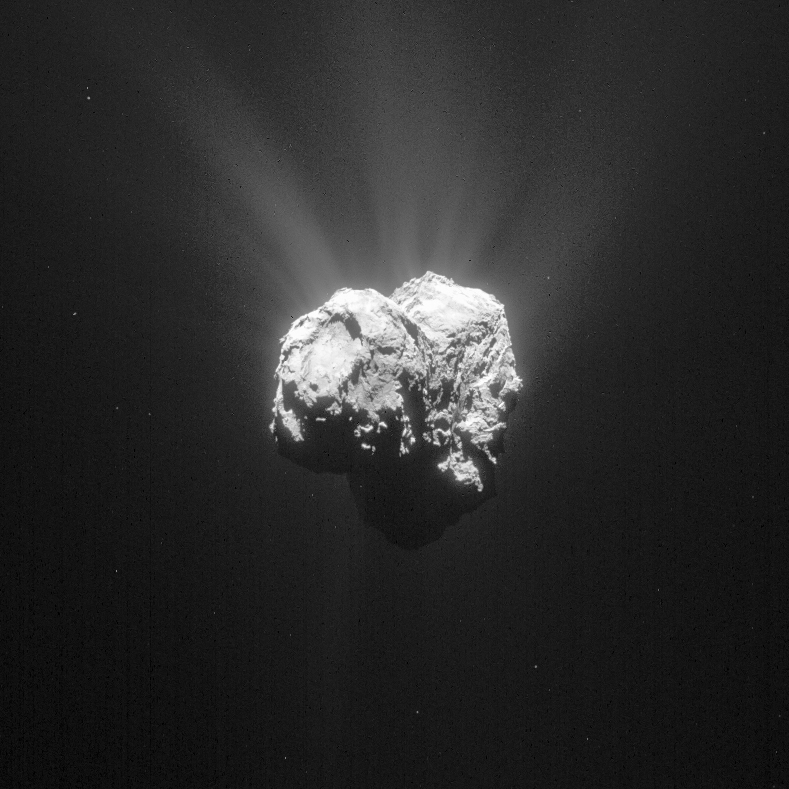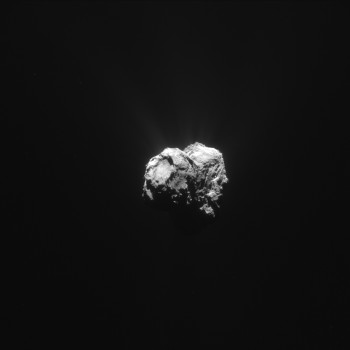Today’s CometWatch entry is a single frame NAVCAM image obtained on 15 April, from a distance of 170 km from the centre of Comet 67P/Churyumov-Gerasimenko. At this distance, the resolution is 14.5 m/pixel; the image has been cropped to 11.4 km (the original frame, provided at the end of the post, measures 14.8 km across).

Cropped and processed single frame NAVCAM image of Comet 67P/C-G taken on 15 April 2015 from a distance of 170 km to the comet centre. Credits: ESA/Rosetta/NAVCAM – CC BY-SA IGO 3.0
Like CometWatch 9 March and 22 March, today’s entry shows 67P/C-G from an unusual angle, revealing some regions on the comet nucleus that in previously published images were partly cast in shadow.
In this orientation, the small comet lobe is on the left, and the large one on the right. The image has been processed to bring out the comet’s activity, showing majestic jets of material emanating from 67P/C-G. Parts of both lobes are visible, in the lower half of the image, as dark silhouettes against the diffuse glow that envelops the nucleus.
The large circular depression on the small lobe is Hatmehit and, to its right, parts of the Bastet region are visible. The large lobe provides an interesting view on the Aker region (the bright-looking portion pointing upwards in this orientation) and on the rough terrains of Khepry (to the right).
The original 1024 x 1024 image is provided below:










Discussion: 13 comments
Thanks a lot Claudia H.NAVCAM Team and ESA for this gift.
Well, explains some clues about morphology suggested at
https://www.esa.int/spaceinimages/Images/2015/04/Comet_on_8_April_2015_NavCam
It is interesting to note that the main jets are still apparently emanating from the two cliff-faces on either side of the Hapi Valley canyon and that they are again bending upwards close to their source (taking account of line-of-sight adjustments) so as to carefully avoid the opposite cliff-face. They thus leave the largely jet-free zone between them which we can see in the image.
The same phenomenon had already been observed recently with the famous “plumber’s pipes”: https://blogs.esa.int/rosetta/2015/03/20/cometwatch-14-march-6-hours-later/, but also, some weeks earlier, in these other two images, among others:
https://blogs.esa.int/rosetta/2015/03/06/cometwatch-28-february/
https://blogs.esa.int/rosetta/2015/02/13/last-stop-before-close-flyby-cometwatch-9-february/
UIAM, we have never seen a *single* image of jets from the opposing cliff-faces of the canyon bending TOWARDS each other and merging (and even less of jets colliding with the opposite cliff-face, as simple hydrodynamic “outgassing” from “nozzles” would presumably expect).
If the standard theory is correct in its basic principles, why should this be the case?
Thomas: Cometwatch 3 February appears to have jets colliding with the opposite cliff-face. One can still ask, does there have to be a special time when one can see this?
In magnification I saw a black double-ball shape against the jet background in the direction up and left of Hatmehit (towards Agilkia). Hopefully not a processing artefact. Assuming that, what can explain the spherical nature of the expelled objects?
Actually now I can see several other black spheres.
Kamal
I found the same double-ball shape against the big jet in the picture 4 hours later, so this must be something connected with the processing and not a real object.
Claudia: Found a few black spheres (double-ball shape not so clear) against the jets in the C image also (15 April 11:55 UT). I also checked some earlier images. Sometimes there are dark shapes against the jets but I don’t see the disinctive double-ball shape.
Claudia: My best guess now is that the double-ball shape is caused by the movement of a single-ball shape around 67p. Is it movement of the object or of the spacecraft? I am not able to understand why it occurs in a single Navcam frame.
I want to point you to the comments on the 28 March (14 km flyby) where I see an “astronaut”, that is, a double-ball shape. Could this represent movement also? If it is movement of the object that is interesting.
Kamal
Hi Lodaya. Analyzed in photo editor the non-processed shot and they are single pixel black up, gray down features. ‘Softening’ at some zoom algorithms bring this kind of artifacts.
Of course, could be seeing different objects.
Yep, some of them come in pairs 🙂
Thanks, Logan. As I mentioned these things can be seen in several pictures, but the one here was striking against the jet.
Far away 67P is now from ‘bag’, ‘ball’ and ‘potato tags! Bravo! Cheers!
Near environment’s luminosity map, as seen at this Comet-watch Apr15 perspective, is quite lineal, as is
core itself.